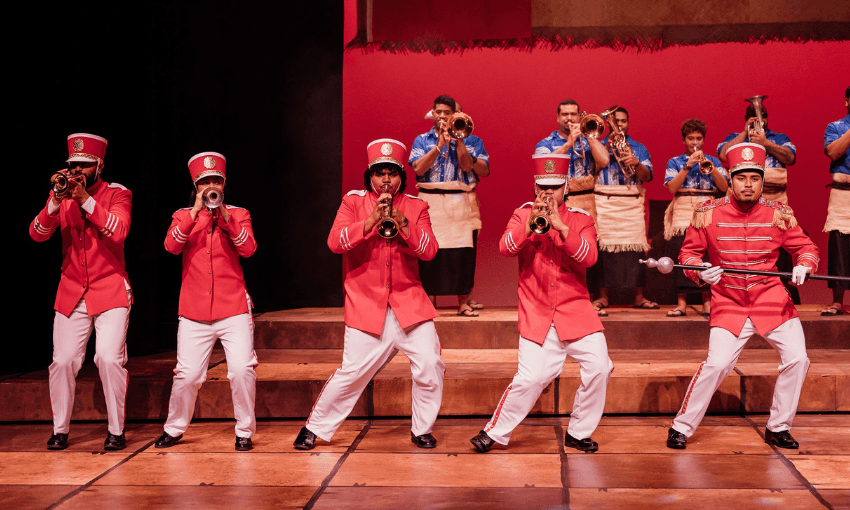After the runaway success of the 2023 film, the Tongan showcase of Red, White and Brass is now a live show. Madeleine Chapman reviews its opening night.
The lowdown
A play based on a movie based on a real-life event, Red, White and Brass is the story of the Tongan group so keen to get to the 2011 Rugby World Cup that they formed a brass band in four weeks in order to provide pre-show entertainment for the France vs Tonga match. The 2023 film was the biggest local film of the year at the box office, bringing in nearly $1.5m so it’s unsurprising that the energy from the cast and fans inspired a very swift play adaptation. A number of actors from the film continue in their roles on stage, most notably JP Foliaki as the lead Maka, equal parts heartwarming and infuriating to his friends and family.
Red, White and Brass: The Play was commissioned by Auckland Theatre Company and is on at the ASB Waterfront Theatre until July 7. The adaptation was written by Leki Jackson-Bourke and directed for the stage by Anapela Polata’ivao.
The good
It’s a play based extremely loyally on the film so any fans of the film will love it. My partner and I both cried watching so that’s something, and there was something quite beautiful about seeing a Tongan flag flying in the audience of a theatre show. Ultimately, it’s the kind of reliable story that will have audiences cheering for it regardless of the execution. And for once, the ASB Waterfront Theatre’s comically large stage was completely in proportion to the show. With a core cast of at least a dozen actors, many on stage at once, the venue felt like the perfect fit. Much more so than when two or three actors are yelling across a vast expanse while also supposedly having an intimate conversation.
Red, White and Brass centres on a tight-knit church community, and relies on the chemistry and camaraderie of a handful of friends and cousins. Maka is the heart and soul of the story, and Foliaki’s inspirational speeches (some deliberately frustrating, others genuinely uplifting) to his increasingly wary brass band are the pit stops throughout the play, letting us check back in on the emotional pulse of the show. The play is Foliaki’s first ever stage performance, and it’s a huge ask to be tasked with leading a massive cast in a big venue. Outside of some opening night jitters, he does an admirable job as Maka, perhaps because he appears to largely just be acting as himself.
Similar to the film, it’s the second act (the tension, the final performance) that shines. Polata’ivao correctly deduced that audiences, Tongan and non-Tongan alike, would want to hear singing and see dancing and feel immersed in the māfana energy. In that respect, the show overdelivers, and the final moments are an incredible pay-off.
At the other end of the spectrum, I was particularly taken by Maka’s parents, played by Onetoto Ikavuka and Sesilia Pusiaki. Ikavuka played Maka’s brother in the film and aged three decades to play his father, Reverend Pita, onstage. You wouldn’t know he was playing outside his demo, though, with his cadence and shuffle perfectly matched to a mid-60s uncle. In one of just a few scenes were only two characters interact, Pusiaki and Ikavuka discuss their troublesome son. It’s a rare quiet moment in the play and one that stands out for the actors’ ability to carry it through without spectacle.
It wouldn’t be an expression of Tongan joy without incredible set design and the wooden church aesthetic plus the heavy-but-accurate deployment of the Tongan flag was a real highlight every time.
The not-so-good
The movie, like many local debut features, barely gets to the standard 90-minute runtime. In fact, it’s only 85 minutes long. It’s short, punchy and full of action. The stage adaptation is a near replica of the film and yet is inexplicably two hours long. You can see where time was added – there are a number of singing performances that were cut short in the film and are left to play out on stage, and silences are allowed to linger in real life more than they can on screen – and they’re positive additions. But I’d argue that should have prompted cuts in other areas.
The first act plays out much the same as in the film, and unnecessarily so. This is where the challenge is set and the premise laid out. It can, and should, be punchy and move through beats swiftly (in a story about a musical performance coming together, ideally we’d get to the music a bit quicker). Instead, it took nearly four full scenes (about 20 minutes) for it to be at all established that Maka and his friends would need to form a brass band in order to make it to the world cup. Where in the film, the short scenes of Maka’s previously failed attempts to secure tickets felt fun and fast, on stage it played out slowly and in a way that didn’t particularly push the narrative along. Ultimately it established Maka as someone with many ideas and not a lot of follow-through, but I would’ve loved to see that presented in a snappier, only-possible-onstage way – I’m imagining more of a montage sequence than three set pieces.
Equally, while the b-plot of the film is Maka’s flirtations with council rep Aroha (Michaela Te Awa Bird), I would’ve happily accepted that “relationship” and Aroha’s involvement being more embedded in the story of the church, rather than as asides. The heart of the story is in the relationships between Maka and his family and church community (not to mention himself). Perhaps in a wide-release film, an element of romance is a requisite, but I think it could’ve been safely removed for the stage. Such a storyline requires a believable chemistry and energy from both actors (such as in the quiet conversation between Maka’s parents). I felt Foliaki and Bird delivered in ensemble moments but struggled under the weight of their two-person scenes.
A snappier first act and trimmed down b-plot would’ve kept the show as energised throughout as it ends up being by the end.
The verdict
I will forever be a supporter of more authentically brown shows being put on by the likes of Auckland Theatre Company. I had my reservations about the location (the waterfront theatre is hardly local for the vast majority of Tongan and Pacific residents) and wondered if ATC’s regular ticket buyers would flock to a brand new and untested show. On the venue front, I’m convinced by ASB Waterfront Theatre as a perfect stage for large, hearty performances. I can only hope the typical theatre crowd is open to accepting such māfana energy into the space.
Red, White and Brass is playing at ASB Waterfront Theatre until July 7. Buy tickets here.






